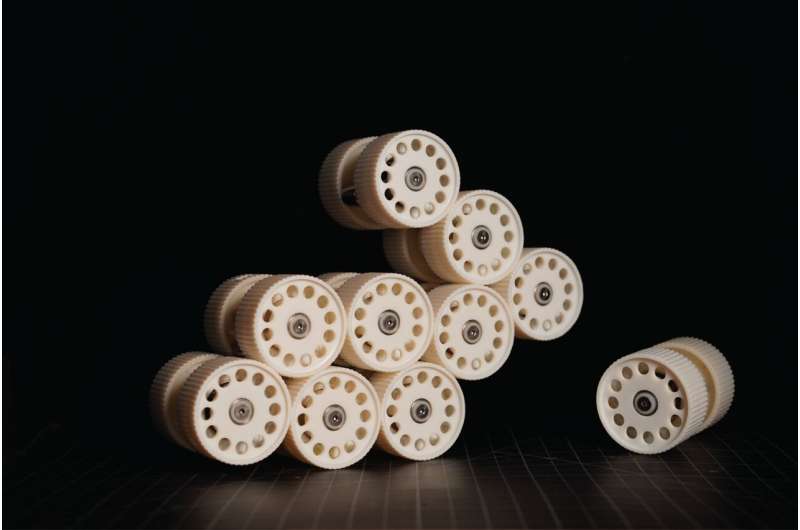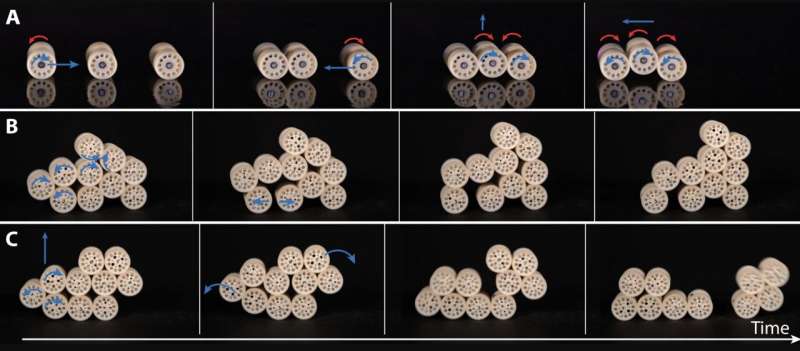Self-organizing robotic aggregate design inspired by flowing and rigid behaviors of sandpiles
[ad_1]
Researchers at the University of Chicago and the Illinois Institute of Technology recently developed Granulobot, a new modular robotic system that can change its physical shape to best navigate different environments.
This system, introduced in Science Robotics, draws inspiration from the ability of bird flocks, fish schools and other assemblies to self-organize their collective behaviors, as well as from the soft adaptive properties of sandpiles (i.e., granular materials).
“While often projects in robotics are motivated by applications, this work emerged from a more fundamental perspective, exploring new paradigms of control computation that leverages the physics of self-organization to design more adaptable and efficient systems, with an ‘artificial life’ outlook,” Baudouin Saintyves, lead author of the paper, told Tech Xplore.
“I am a physicist, engineer, and artist, with expertise in pattern formation and in robotics as a medium. I am interested in exploring the emergence of life-like properties in non-living systems.”
As part of this recent study, the researchers set out to develop a robot that could rapidly adapt its shape to move in different environments. The robot they designed builds on previous work carried out at the University of Chicago’s Jaeger Lab focusing on the physics of soft granular matter (e.g., sand piles and corn starch suspensions), as well as Saintyves’ fascination with reproducing physical patterns in robots.
“In contrast with a top-down problem-solving approach, common in engineering, here we employ a bottom-up approach, more common in experimental physics,” Saintyves said. “We ask how an assembly of very simple granular building blocks, such as grains in a pile of sand, can lead to emergent intelligent properties when these grains are augmented with actuation capabilities.
“Similarly to cells in tissues or birds swirling together, by designing systems that can self-organize and that can use remarkable properties of granular aggregates, we can embody a form of emergent ‘intelligence’ in modular robotic systems.”
Saintyves and his colleagues have been trying to produce “intelligent” robotic systems that draw their intelligence from physical principles, rather than machine learning and other digital computations. As machine learning algorithms and other complex computations can be computationally demanding, these systems could exhibit a lower power consumption and thus longer battery life.
Saintyves has been studying how patterns emerge in nature for years, with a keen interest on the self-organization properties of soft materials, such as gels, grains and viscoelastic materials. His research explored these phenomena from a physical standpoint, as well as from a more artistic perspective.
“Self-organization shapes the natural world around us,” he said. “Combined with other fundamental principles such as evolution, it gives rise to life and intelligence, simply from physical forces that precede us, and can be observed at all scales from DNA self-assembly or cells in tissues, to ant colonies or birds swirling together.
“While a visiting artist at the University of Chicago and an artist in residence in a contemporary art center, I developed a live cinema performance that uses self-organization as a ‘puppetry’ staging an emerging life. During this project, I built my first robotic systems.”
His fascination with “artificial life” ultimately drew Saintyves to the field of robotics, encouraging to initiate a collaboration with roboticist and soft matter physics expert Heinrich Jaeger at the James Franck Institute. Jaeger has been studying sand piles, corn starch suspensions, and other granular materials, with an interest for its potential applications in robotics.
“The design of Granulobots demonstrates a general control approach that leverages the highly adaptable properties of soft materials, here granular materials, with either liquid or solid responses, combining them with self-organization principles,” Saintyves said.
In their paper, the researchers introduced a new form of embodied intelligent system. This system is designed to adapt its body structure leveraging physical principles alone, without relying on any digital computations.

“Designing robotic systems capable of changing their shape and flexibility to adapt to various environments remains a major engineering challenge,” Saintyves said. “To address this, we introduce Granulobots, a self-reconfigurable robotic system inspired by the highly adaptative properties of granular matter. Picture it as a collection of grains that connect to form aggregates, similar to a wet sandpile, but now with motorized grains.”
The Granulobots designed by Saintyves and his colleagues are small systems that can unite, separate and produce different structures by applying torque to each other. The robots’ self-organization capabilities allow them to continuously adapt and deform, just like liquid or solid materials do,
The local control parameters set in all Granulobots allow them to self-coordinate their movements to produce suitable aggregate locomotion styles for different environmental conditions, without receiving any input from a central computer. Their movements thus the product of mechanical interactions.
“Aggregates can ‘flow’ over obstacles, and self-coordinate to slide on slippery surfaces, or crawl and roll on anti-slip grounds, without wireless communication between robots,” Santyves said. “This design demonstrates a form of control computing based on mechanical feedback rather than sophisticated electronics and sensors, advancing the development of resilient robotic systems with the ability to morph and adapt to various functions and conditions.”
The innovative robotic design introduced by Saintyves and his collaborators enables the co-existence of various remarkable properties in a single body, employing a simple decentralized control framework. Its underlying principles open interesting opportunities for the creation of intelligent robots, blurring the lines between swarm, soft and modular robotics.
“This work opens the possibility for a new paradigm of control computation that is by design more adaptable to environmental changes with a smaller digital computation and energy footprint,” Saintyves said. “Reversing the principle ‘the material is the machine’ that triggered exciting research on compliant mechanism where a carefully designed metamaterial can exhibit machine-like properties, we take the opposite stance: ‘the machine is the material.’ This principle is broadly used by nature to embody intelligence efficiently.”
The researchers demonstrated the potential of their design in various initial tests, which demonstrated its ability to autonomously self-coordinate the movements of robots and adapt to changing environments with minimal digital computations. In their next studies, they plan to further improve their Granulobots to also support autonomous decision-making and the decentralized optimization of parameters to identify optimal locomotion gaits.
These improvements could allow the robots to autonomously identify the best locomotion gaits to navigate specific environments, to then switch between gaits when conditions change.
“This is not a difficult goal to reach, as decentralized control strategies have been implemented in the past in swarm robotic systems, but they are based on agent behaviors that can be programmed locally,” Saintyves said. “Going back to the initial questions I asked when starting this project, ‘how an assembly of very simple granular building blocks, such as grains in a pile of sand, can lead to emergent intelligent properties when these grains are augmented with actuation capabilities,’ here it is natural to ask how minimal and physical such agent behaviors can be in implementing decision making or more sophisticated learning collective properties.”
In their future work, Saintyves and his colleagues also plan to create a three-dimensional (3D) Granulobot-based system. This could either be done by creating robotic units comprised by more complex aggregates of 2D Granulobots or by designing a spherical version of their modular robot.
“I anticipate that new interesting physics will emerge from such features, and in turn new opportunities to leverage mechanical forms of control computation,” Saintyves added. “Lastly, designing an optimal system with just the required properties will allow us to miniaturize and develop a more continuous form of robotic matter. Sci-fi characters such as T-1000 in terminator or the Sandman in Spiderman will then become closer to reality.”
More information:
Baudouin Saintyves et al, A self-organizing robotic aggregate using solid and liquid-like collective states, Science Robotics (2024). DOI: 10.1126/scirobotics.adh4130
© 2024 Science X Network
Citation:
Self-organizing robotic aggregate design inspired by flowing and rigid behaviors of sandpiles (2024, March 19)
retrieved 19 March 2024
from https://techxplore.com/news/2024-03-robotic-aggregate-rigid-behaviors-sandpiles.html
This document is subject to copyright. Apart from any fair dealing for the purpose of private study or research, no
part may be reproduced without the written permission. The content is provided for information purposes only.
[ad_2]


